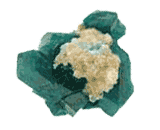| Gemstone Chart |
 Natural Dioptase Natural Dioptase
Dioptase is an intense emerald-green to bluish-green copper cyclosilicate mineral.Dioptase is a rather unusual gemstone that will rarely be found in your basic jewelry stores. It is a beautiful gemstone with a very unusual combination of green colors.
Color: Dark blue green, emerald green, or turquoise
Categories: semi-precious stone
Chemical Composition: CuSiO2(OH) 2
Crystal Group: Hexagonal
Refractive Index: RI 1.644 ¨C 1.709
Hardness: 5
Density: 3.28 ¨C 3.55
Occurrence: Russia, Tsumeb Namibia, California and Colorado USA, Congo, Zaire, Chile
|  Natural Lapis Natural Lapis
Lazurite is a popular but generally expensive mineral. Well-formed, deep blue crystals are rare and valuable. Lapis lazuli is a gemstone of the kind that might have come straight out of the Arabian Nights: a deep blue with golden inclusions of pyrites which shimmer like little stars.
Color: Blue, greenish-blue, violet blue
Categories: semi-precious stone
Chemical Composition: A complex aggregate
Crystal Group: Not applicable
Refractive Index: 1.5
Hardness: 5.5
Density: 2.7-2.9
Occurrence: Afganistan, Pakistan, Chile, Russia, U.S.A., Angola, Burma
|  Natural Turquoise Natural Turquoise
Turquoise is an opaque, blue-to-green mineral that is a hydrous phosphate of copper and aluminium.The gem turquoise owes it's beauty almost entirely to its superb color. It has been used for ornamentation since 3000BC and possibly before.
Color: Blue, Greenish Blue
Categories: semi-precious stone
Chemical Composition: CuAl6(PO4)4(OH)85H2O
Crystal Group: Triclinic
Refractive Index: 1.62
Hardness: 5.5-6
Density: 2.60- 2.90
Occurrence: Iran, USA, India, Tibet, China, Egypt, Chile, Russia, Australia
|
|
